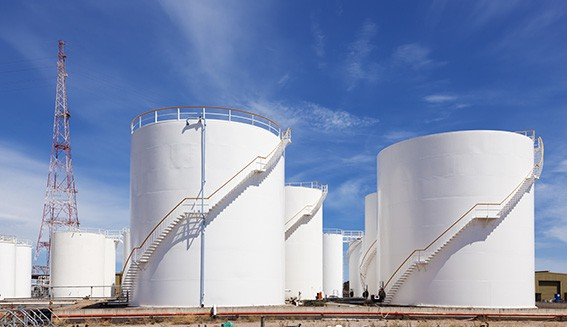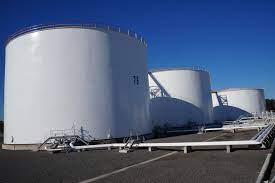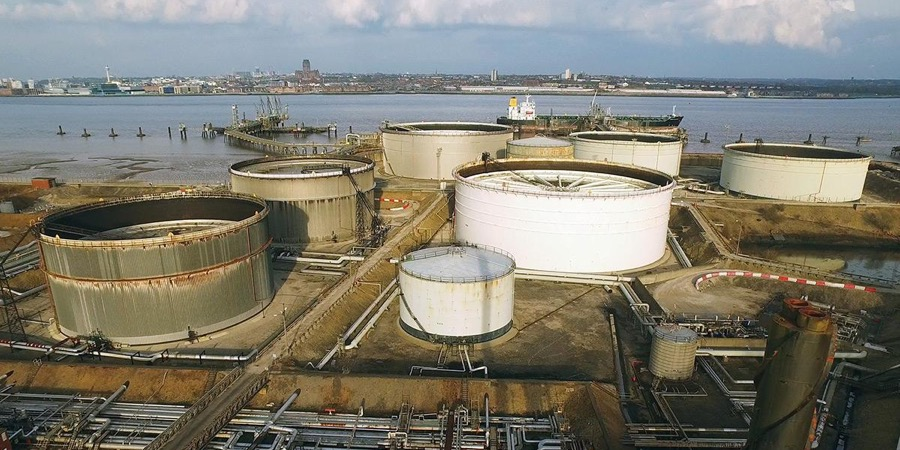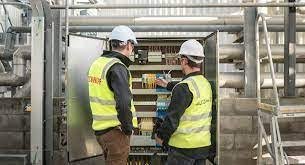Tank Farm Associate (1 years diploma)
Tank Farm Associate click here
Brief Job Description: The individual operates pipeline for loading/unloading of
cargo, cleans tanks, and monitors tanks for liquid level, pressure, emergency
alarms etc.
Qualifications Pack for Tank Farm Associate
Option 1: Tank Farm Supervision
This unit is about supervision of operations, monitoring, inspecting and inventory
tracking of tank farms

Personal Attributes:
The job holder should be medically and physically fit to operate liquid terminals
and monitor tank farm operations. S/he should be observant and diligent in
monitoring the alarms, gauges and meters during operations and maintenance.
Description
Core Skills/Generic
Skills
Core Skills or Generic Skills are a group of skills that are key to learning and
working in today’s world. These skills are typically needed in any work
environment. In the context of the NOS, these include communication related
skills that are applicable to most job roles.
Function
Function is an activity necessary for achieving the key purpose of the sector,
occupation, or area of work, which can be carried out by a person or a group
of persons. Functions are identified through functional analysis and form the
basis of NOS.
Job role Job role defines a unique set of functions that together form a unique
employment opportunity in an organization.
Knowledge and
Understanding
Knowledge and Understanding are statements which together specify the
technical, generic, professional and organizational specific knowledge that an
individual needs in order to perform to the required standard.
National Occupational
Standards (NOS) NOS are Occupational Standards which apply uniquely in the Indian context
Electives
Electives are NOS/set of NOS that are identified by the sector as contributive
to specialization in a job role. There may be multiple electives within a QP for
each specialized job role. Trainees must select atleast one elective for the
successful completion of a QP with Electives

Options
Options are NOS/set of NOS that are identified by the sector as additional
skills. there may be multiple options within a QP. It is not mandatory to select
any of the options to complete a QP with Options.
Unit Code Unit code is a unique identifier for an Occupational Standard, which is
denoted by an ‘N’
Unit Title Unit title gives a clear overall statement about what the incumbent should be
able to do.
Occupation Occupation is a set of job roles, which perform similar/related set of functions
in an industry.
Organisational Context
Organisational Context includes the way the organization is structured and
how it operates, including the extent of operative knowledge managers have
of their relevant areas of responsibility.
Performance Criteria Performance Criteria are statements that together specify the standard of
performance required when carrying out a task.
Qualifications
Pack(QP)
Qualifications Pack comprises the set of NOS, together with the educational,
training and other criteria required to perform a job role. A Qualifications
Pack is assigned a unique qualification pack code.
Qualifications Pack
Code
Qualifications Pack Code is a unique reference code that identifies a
qualifications pack.
Scope
Scope is the set of statements specifying the range of variables that an
individual may have to deal with in carrying out the function which have a
critical impact on the quality of performance required.
Sector
Sector is a conglomeration of different business operations having similar
businesses and interests. It may also be defined as a distinct subset of the
economy whose components share similar characteristics and interests.
Sub-Sector Sub-sector is derived from a further breakdown based on the characteristics
and interests of its components.
Sub-functions Sub-functions are sub-activities essential to fulfil the achieving the objectives
of the function.
Technical Knowledge Technical Knowledge is the specific knowledge needed to accomplish specific
designated responsibilities.
Description
API American Petroleum Institute
ERP Enterprise Resource Planning
EXIM Export Import
HR Human Resources

IEC International Electrotechnical Commission
MHE Material Handling Equipment
NFPA National Fire Protection Association
NSQF National Skills Qualifications Framework
OH&S Occupational Health and Safety
OS Occupational Standards
OSHA Occupational Safety and Health Administration
PPE Personal Protective Equipment
QP Qualifications Pack
SOP Standard Operating Procedures
Monitor tank operations and perform basic maintenance
Description This unit is about monitoring the readings of different gauges to track tank status,
conduct physical checks and perform basic maintenance
Scope This unit/task covers the following:
• Monitor tank operations
• Perform basic maintenance activities
Range: Tank, control and measuring equipment’s, tools and tackles, fire fighting
systems and alarms, consumables, Standard Operating Procedures (SOP), computer,
projector, worksheets, etc.
Performance Criteria(PC) w.r.t. the scope
Element Performance Criteria
Monitor tank
operations
To be competent, the user/ individual must be able to:
PC1. check readings of different tank operation gauges
PC2. track reading of cargo levels, particularly range level for liquid and pressurised
cargo
PC3. monitor performance of pumps using the control unit
PC4. check for fitness of firefighting systems and safety alarms
Perform basic
maintenance
activities
To be competent, the user/ individual must be able to:
PC5. execute preventive maintenance check as per SOP
PC6. perform physical rounds to check for tank integrity and report issues if any
PC7. check and ensure that emergency pathways are not obstructed, and
emergency systems are easily accessible
PC8. check that valves and pumps function normally without any aberrations
PC9. perform basic troubleshooting checks like surface painting, cleaning of
exteriors, clearance for safety valves and emergency systems
PC10. escalate issues that need external technical repairs, servicing and hazardous
scenarios
Knowledge and understanding (K)
A. Organizational
context
(Knowledge of the
company /
organization and
its processes)
The individual on the job needs to know and understand:
KA1. organizational procedures and SOPs for tasks at hand, documentation policy
and emergency responses
KA2. security and safety procedures to be followed
KA3. reporting structure of the organization and the supplier for escalation of
issues
KA4. risk and impact of not following defined procedures/work instructions
KA5. coding system followed for different type of liquids and their distress codes
B. Technical knowledge
The individual on the job needs to know and understand:
KB1. different type of cargo, their classification – A, B, C and their handling
procedure and precautions
KB2. SOPs for different operations, petro-chemical standards – International
Electrotechnical Commission (IEC) 61511, IEC 61508, American Petroleum
Institute (API) 2350, National Fire Protection Association (NFPA), Oil industry
safety directorate guidelines and various committee recommendations
KB3. using fire extinguisher and protocols for emergencies

KB4. operations of control systems pumps, valves, alarm systems, etc.
KB5. documentation requirement for different type of cargo and their handling
KB6. handling and emergency procedures for hazardous cargo
Skills (S)
A. Core skills/
generic skills
Reading skills
The user/individual on the job needs to know how to read:
SA1. written instructions
SA2. ERP alarms, message and notifications
SA3. checklists
Writing skills
The user/individual on the job needs to know how to write:
SA4. monitoring report
SA5. update maintenace logs
Oral communication (listening and speaking skills)
The user/individual on the job needs to know how to:
SA6. communicate with supervisors, ground workforce, pumping attendants,
transport operators
B. Professional skills Decision making
The user/individual on the job needs to know how to:
SB1. decide and identify leakages if any
SB2. identify damage or abnormalities in tank structure
Plan and organize
The user/individual on the job needs to know how to:
SB3. plan and coordinate between teams to achieve joint goals.
SB4. maintain punctuality and respond in a timely manner
SB5. prioritize and execute tasks based on checklist and priorty requirements
SB6. do a check of activity completion
Customer centricity
The user/individual on the job needs to know how to:
SB7. adhere to the assigned timelines
SB8. address the urgency regarding shipments and emergencies
Problem solving
The user/individual on the job needs to know how to:
SB9. response procedure for fixing small leaks
SB10. anticipate hazardous situations and raise alarms for preventive actions
Analytical thinking
The user/individual on the job needs to know how to:
SB11. monitor gauges and identify anomalies
SB12. estimate ageing of cargo and periodic requirement for tank maintenance
Critical thinking
The user/individual on the job needs to know and understand how to:
SB13. identify if there is a leakage or fracture
SB14. raise alarm and emergency response in case of hazardous situations
Assist in tank cleaning and residual collection
Description This unit is about assisting in residual collection and tank cleaning activities
Scope This unit/task covers the following:
• Work safely
• Residual collection
• Dry cleaning
• Wet cleaning
• Steam cleaning
• Chemical cleaning
Range: Tank, control and measuring equipment, tools and tackles, fire-fighting
systems and alarms, cleaning equipment, consumables, Standard Operating
Procedures (SOP), computer, projector, worksheets, etc.
Performance Criteria(PC) w.r.t. the scope
Element Performance Criteria
Work safely To be competent, the user/individual must be able to:
PC1. adhere to procedures and guidelines for Personal Protective Equipment (PPE)
and other relevant safety regulations while performing cleaning and
collection
PC2. ensure that all hand tools and equipment used are in a safe and serviceable
condition
PC3. ensure work area is clean and safe from hazards
Residual collection To be competent, the user/ individual must be able to:
PC4. pump the liquid out of the storage tank as per SOP
PC5. measure the residual oil in tank to ensure that the concentration of oil and
gas are within a safe range
PC6. use chemical additives and hydrocarbon diluents to liquefy solid sludge
deposits
PC7. extract the liquid using standard pumping and liquid circulation arrangements
PC8. ventilate the tank to expel the gas and oil from the tank
PC9. dispose the residue in a safe manner as per SOP
Dry cleaning To be competent, the user/ individual must be able to:
PC10. enter the tank and clean the tank floor and lower walls using sawdust
PC11. remove the sawdust and the local corrosion using tools
PC12. thoroughly mop and clean the floor and walls
Wet cleaning To be competent, the user/ individual must be able to:
PC13. clean the tank with pressurised water as per SOP
PC14. drain the sewage liquid and clean the tank using mop
PC15. ventilate with dry wind for dehumidification
PC16. remove local corrosion using tools
Steam cleaning To be competent, the user/ individual must be able to:
PC17. clean the oil tank with steam
PC18. wash tough oil with high pressure stream
PC19. clean thoroughly with mop
Chemical cleaning To be competent, the user/ individual must be able to:
PC20. wash the tank using tank cleaning chemicals
PC21. allow pickling and de-rusting as per procedural timelines
PC22. remove the acid and clean the tank with water
PC23. drain sewage and perform passivation treatment
PC24. wash the tank with high pressure water
PC25. drain sewage and clean the tank using mop
PC26. ventilate with dry air for dehumidification
Knowledge and understanding (K)
A. Organizational
context
(Knowledge of the
company /
organization and
its processes)
The individual on the job needs to know and understand:
KA1. organizational procedures and SOPs for tasks at hand, documentation policy
and emergency responses
KA2. security and safety procedures to be followed
KA3. reporting structure of the organization and the supplier for escalation of
issues
KA4. risk and impact of not following defined procedures/work instructions
KA5. coding system followed for different type of liquids and their distress codes
B. Technical
knowledge
The individual on the job needs to know and understand:
KB1. different type of cargo, their classification – A, B, C and their handling
procedure and precautions

KB2. SOPs for different operations, petrochemical standards – International
Electrotechnical Commission (IEC) 61511, IEC 61508, American Petroleum
Institute (API) 2350, National Fire Protection Association (NFPA), Oil industry
safety directorate guidelines and various committee recommendations
KB3. using fire extinguisher and protocols for emergencies, pollution and leakages
KB4. operations of control systems pumps, valves, alarm systems, etc.
KB5. documentation requirement for different type of cargo and their handling
KB6. different type of cleaning methods, systems and equipment and their use for
specific cargo
KB7. various risks associated with different cargo when cleaning
Skills (S)
C. Core skills/
generic skills
Reading skills
The user/individual on the job needs to know how to read:
SA1. written instructions
SA2. maintenance and service logs, pressure and level gauges
SA3. checklists
Writing skills
The user/individual on the job needs to know how to write:
SA4. cleaning reports
SA5. cleaning and maintenance logs
Oral communication (listening and speaking skills)
The user/individual on the job needs to know how to:
SA6. communicate with supervisors, managers, third party cleaning agents
D. Professional skills Decision making
The user/individual on the job needs to know how to:
SB1. identify corrosion while cleaning and clear it
SB2. assess if all the residual cargo has been removed
SB3. decide if de-humidification, cleaning process is complete and tank is fit for
loading
Plan and organize
The user/individual on the job needs to know how to:
SB4. plan and coordinate between teams to achieve joint goals.
SB5. maintain punctuality and respond in a timely manner
SB6. prioritize and execute tasks based on checklist and priorty requirements
Customer centricity
The user/individual on the job needs to know how to:
SB7. adhere to the assigned timelines
SB8. address the urgency and precautions regarding cleaning process
Problem solving
The user/individual on the job needs to know how to:
SB9. anticipate requirement for cleaning – removal of rust, residual, etc.
SB10. anticipate residual cargo in tank and ways to extract it
Analytical thinking
The user/individual on the job needs to know how to:
SB11. assess the variation in loading and unloading to estimate residual cargo
Critical thinking
The user/individual on the job needs to know and understand how to:
SB12. identify if there is a leakage, fracture or corrosion
SB13. identify emergencies and raise alarms, during cleaning process
Operate and maintain pipeline
Description This OS unit is about operation, maintaining and monitoring of pumps
Scope This unit/task covers the following:
• Flush pipeline
• Make pipeline connection and operate pumps
• Check for pressure and resolve issues along the pipeline
Range: Tank, pipelines, control and measuring equipment, tools and tackles, firefighting systems and alarms, liquid cargo, control console, consumables, Standard
Operating Procedures (SOP), computer, projector, worksheets, etc.
Performance Criteria(PC) w.r.t. the Scope
Element Performance Criteria
Flush pipeline To be competent, the user/individual on the job must be able to:
PC1. perform chemical alkali flushing followed by acidic flushing to remove dirt,
contamination, etc.
PC2. perform filter check at both ends to ensure clean and turbulent movement of
flush

PC3. monitor the pressure of the flush at different gauges installed in the pipeline
and provide information to pipeline control unit
PC4. report to control unit once flushing is complete
Make pipeline
connection and
operate pumps
To be competent, the user/ individual must be able to:
PC5. make connections using valves and angles, and connect the pipeline to the
vessel for release of cargo
PC6. check pipeline connection with storage tank for any leaks, seal tight closure
and pressure in gauges where connections have been made
PC7. operate the pumps for transfer of cargo from vessel to tank or vice versa
PC8. check for collection and operate drainage taps at bends and crests in pipelines
Check for pressure
and resolve issues
along the pipeline
To be competent, the user/ individual must be able to:
PC9. observe the pressure and the temperature in the pipeline using various
pressure and temperature gauges installed
PC10. monitor reading of the same and escalate to control room in-case it crosses
threshold limits
PC11. check for leakages or severed connections when pressure drops, make
necessary adjustments and provide a go ahead of releasing cargo again
PC12. provide report to the supervisor regarding cargo transferred, any technical
challenges, accidents, damages, etc.
A. Organizational
Context
(Knowledge of the
company /
organization and
its processes)
The individual on the job needs to know and understand:
KA1. organizational procedures and SOPs for tasks at hand, documentation policy
and emergency responses
KA2. security and safety procedures to be followed
KA3. reporting structure of the organization and the supplier for escalation of
issues
KA4. risk and impact of not following defined procedures/work instructions
KA5. coding system followed for different type of cargo and their distress codes
B. Technical
Knowledge
The individual on the job needs to know:
KB1. basic technicalities and controls and switches used to operate the pipeline
KB2. various signs and signals used for operations and emergencies at the port
KB3. SOPs for handling hazardous goods
KB4. response to emergencies e.g. fire
KB5. pre-operation checklist and post operation checklists
KB6. safety regulations while operating the pipeline
KB7. optimal working condition at the port and various precautions to be taken
because of weather
KB8. the control systems, greasing and other technical requirement for the pipeline
KB9. various pipeline components and their functions
KB10. how to test and safely carry out maintenance tasks on the pipeline
KB11. how to identify deviations from normal operations
KB12. basic of port and yard layouts

KB13. type of vessels and sops for cargo movement in each type
KB14. different type of cargo, their classification – A, B, C and their handling
procedure and precautions
KB15. SOPs for different operations, petrochemical standards – International
Electrotechnical Commission (IEC) 61511, IEC 61508, American Petroleum
Institute (API) 2350, National Fire Protection Association (NFPA), Oil industry
safety directorate guidelines and various committee recommendations
KB16. using fire extinguisher and protocols for emergencies, pollution and leakages
KB17. operations of control systems pumps, valves, alarm systems, etc.
Skills (S)
A. Core Skills/
Generic Skills
Reading Skills
The user/individual on the job needs to know how to read:
SA1. labels and codes as per company procedures
SA2. various signals and flags in port, liquid terminal and vessel operations
SA3. handling instructions/company log books and records
SA4. SOPs and safety manuals and safety signs at the port
SA5. instructions and orders








